Best laptops for mechanical engineering students | As a mechanical engineering student, you’ll need a powerful and reliable laptop to tackle demanding software, complex simulations, and detailed 3D modeling. Choosing the right laptop can be overwhelming, especially with the rapidly evolving technology landscape. But fear not! This guide will help you navigate the options and find the perfect machine to fuel your engineering journey.
Mechanical Engineering Laptop Requirements
- Operating System: Windows 10 or 11, macOS Monterey or later
- Processor: Intel Core i5 or AMD Ryzen 5 processor (11th generation or later)
- RAM: 16 GB (32 GB recommended)
- Storage: 512 GB SSD (1 TB recommended)
- Graphics Card: NVIDIA GeForce GTX 1650 or AMD Radeon RX 5500M (dedicated graphics card recommended)
- Display: 15.6-inch FHD (1920 x 1080) resolution
- Ports: USB 3.0 ports, HDMI port, Ethernet port
Best Laptops for Mechanical Engineering Students
- Dell XPS 15 9520 OLED Touchscreen Business Laptop ($2,499)
- Apple MacBook Pro Laptop M3 Pro chip ($2,299)
- MSI Creator M16 16″ 60Hz QHD+ Content Creation Laptop ( $1,364)
- HP Envy 16 Laptop ($1,559)
- ASUS VivoBook S 15 OLED Slim Laptop ($999)
- Lenovo ThinkPad P16s Workstation Business Laptop ($1,099)
1. Dell XPS 15 9520 OLED Touchscreen Business Laptop
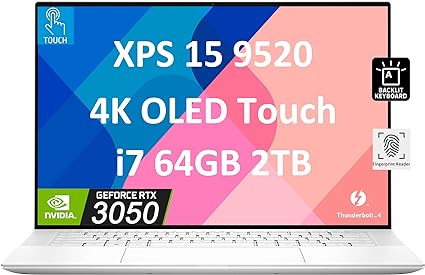
| Model Name | DELL XPS 15 9520 |
| Screen Size | 15.6 Inches |
| Color | White |
| Hard Disk Size | 2 TB |
| CPU Model | Core i7 |
| Ram Memory Installed Size | 64 GB |
| Operating System | Windows 11 Home |
| Graphics Card Description | Dedicated |
The Dell XPS 15 9520 packs a powerful punch and is a compelling choice for mechanical engineering students. Let’s break down its features to see why:
Properties of XPS 15 9520
- 12th Gen Intel Core i7-12700H Processor: This 14-core processor delivers the horsepower needed for demanding engineering software like CAD and simulations.
- 64GB DDR5 RAM: Multitasking between complex calculations and design programs becomes a breeze with this ample amount of RAM.
- 2TB PCIe NVMe M.2 SSD: Store all your files, projects, and software with ample and speedy storage.
- 15.6-inch 4K OLED Touchscreen: The stunning OLED display with its vibrant colors and deep blacks makes working on 3D models and engineering drawings a joy.
- GeForce RTX 3050 Ti Graphics: This dedicated graphics card can handle light gaming and helps accelerate some engineering applications.
- Expandable to 4 monitors: Connect additional displays for extended workspace and enhanced productivity.
- Long Battery Life: Stay productive throughout long days in the lab or classroom without worrying about finding an outlet.
The Dell XPS 15 9520 is a powerful and portable laptop that is well-suited for the demanding needs of mechanical engineering students. With its powerful processor, ample RAM, stunning display, and dedicated graphics, this laptop can handle any task you throw at it. Additionally, its long battery life and durable design make it a perfect companion for students on the go.
2. Apple MacBook Pro Laptop M3 Pro chip

| Model Name | MacBook Pro |
| Screen Size | 16.2 Inches |
| Hard Disk Size | 512 GB |
| Ram Memory Installed Size | 18 GB |
| Operating System | Mac OS |
| Graphics Card Description | Integrated |
| Graphics Coprocessor | Apple Integrated Graphics |
The new MacBook Pro, powered by the M3 Pro or M3 Max chip, is a powerful and versatile laptop that could be a great choice for mechanical engineering students. Here are some of its features that make it suitable for this demanding field:
Properties of MacBook Pro
Performance:
- M3 Pro chip: 12-core CPU and 18-core GPU, delivering incredible performance for demanding workflows like manipulating large CAD models, running simulations, and analyzing data.
- M3 Max chip: Up to 16-core CPU and 40-core GPU, offering extreme performance for the most advanced tasks like 3D rendering and developing complex AI models.
- Long battery life: Up to 22 hours on a single charge, which is crucial for working long days in the lab or classroom without a power outlet.
Display:
- 16.2-inch Liquid Retina XDR display: Offers stunning visuals with Extreme Dynamic Range, over 1000 nits of brightness for HDR content, and pro reference modes for accurate color reproduction. This is essential for working with detailed designs and simulations.
Software compatibility:
- Runs all your pro apps: Supports popular engineering software like SolidWorks, MATLAB, AutoCAD, and more.
- macOS: Provides a powerful and intuitive operating system for efficient work and collaboration.
Additional features:
- Advanced camera and audio: Perfect for video calls and presentations.
- Connectivity: Thunderbolt 4 ports, SDXC card slot, HDMI port, and headphone jack for connecting all your peripherals.
- Wi-Fi 6E: Latest wireless standard for fast and reliable internet connectivity.
- Magic Keyboard with Touch ID: Comfortable and secure typing experience.
- Advanced security: Built-in encryption and virus protection for peace of mind.
- Works with other Apple devices: Seamless integration with iPhone, iPad, Apple Watch, and other Apple devices for enhanced productivity.
- Built to last: All-aluminum unibody enclosure for durability.
- Free software updates: Regular updates keep your Mac secure and up-to-date.
Overall, the MacBook Pro is a powerful and versatile laptop that can be a valuable tool for mechanical engineering students. Its combination of performance, display quality, software compatibility, and features makes it a compelling choice for anyone looking for a top-of-the-line laptop for their studies.
3. MSI Creator M16 16″ 60Hz QHD+ Content Creation Laptop
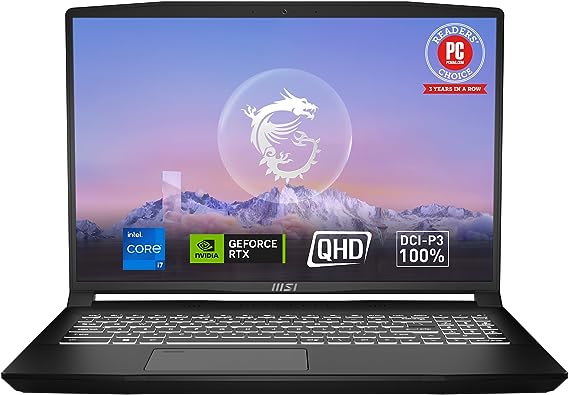
| Model Name | Creator M16 B13VF-453US |
| Screen Size | 16 Inches |
| Hard Disk Size | 1 TB |
| CPU Model | Core i7 |
| Ram Memory Installed Size | 32 GB |
| Operating System | Windows 11 Home |
| Graphics Coprocessor | NVIDIA GeForce RTX 4060 |
| CPU Speed | 2.4 GHz |
The MSI Creator M16 seems to offer a compelling set of features that could make it a strong candidate for mechanical engineering students. Let’s break down the key aspects:
Properties of Creator M16
- 13th Gen Intel Core i7 Processor: The latest generation Intel Core i7 processor is a powerful choice for handling demanding tasks in mechanical engineering software and simulations. Its ability to handle gaming and content creation adds versatility to the laptop.
- NVIDIA GeForce RTX 4060 GPU: The inclusion of an RTX 4060 GPU is excellent for mechanical engineering tasks that involve 3D modeling and rendering. The ray tracing capability enhances visualizations, providing a more realistic representation of designs.
- QHD+ Display with 16:10 Aspect Ratio: The 16-inch QHD+ display with a 16:10 aspect ratio and 100% DCI-P3 color gamut is beneficial for mechanical engineering students working on CAD software. The increased screen real estate and color accuracy contribute to a more immersive and detailed viewing experience.
- Windows 11 Pro Recommendation: The recommendation for Windows 11 Pro is a positive note for business and professional use, aligning well with the needs of mechanical engineering students who may engage in complex projects and collaborations.
- Simplistic Design and Flip-n-Share Feature: The simplistic design and the ability to lay the laptop flat with ultra-thin bezels enhance the collaborative aspect of the laptop. This feature can be particularly useful for group discussions and sharing ideas with peers.
In summary, the MSI Creator M16 appears to be a strong contender for mechanical engineering students due to its powerful hardware specifications, high-quality display, and features that facilitate collaboration and content sharing. The combination of a robust processor, dedicated GPU, and thoughtful design elements positions it well for handling the demanding tasks associated with mechanical engineering studies.
4. HP Envy 16 Laptop
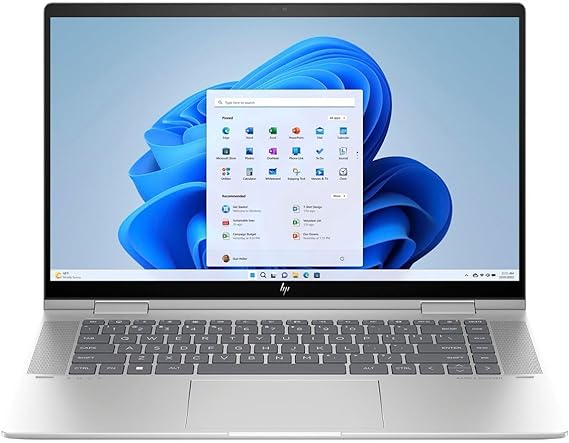
| Model Name | HP ENVY 16 Laptop |
| Screen Size | 16 Inches |
| Color | Silver |
| Hard Disk Size | 2 TB |
| CPU Model | Core i9 |
| Ram Memory Installed Size | 32 GB |
| Operating System | Windows 11 Home |
| Graphics Card Description | Dedicated |
| Graphics Coprocessor | NVIDIA GeForce RTX 4060 |
The HP ENVY 16 Laptop, as described, offers several features that make it an excellent choice for mechanical engineering students:
Properties of ENVY 16
- Powerful Processor: The Intel Core i9 13900H processor with 14 cores and 20 threads, capable of reaching speeds up to 5.4GHz, provides the computational power needed for demanding mechanical engineering software and simulations.
- Dedicated Graphics: The NVIDIA GeForce RTX 4060 dedicated graphics card ensures smooth rendering of 3D models, simulations, and CAD software commonly used in mechanical engineering projects.
- Ample RAM: With up to 64GB DDR5-5200 MHz RAM, the laptop can handle multitasking and memory-intensive tasks efficiently, enabling seamless switching between various engineering applications.
- Large SSD Storage: Up to 2TB SSD storage offers ample space to store large design files, projects, and software installations, ensuring quick access and data retrieval for engineering tasks.
- High-Resolution Touch-Screen Display: The 16-inch WQXGA touch-screen display with a resolution of 2560 x 1600 provides a spacious and vibrant workspace for viewing intricate designs, schematics, and engineering drawings with clarity and precision.
- Windows 11 Home Operating System: Windows 11 Home offers a modern and intuitive user interface, enhancing productivity and creativity with its streamlined design and new features, which can benefit mechanical engineering students in organizing their work and accessing resources efficiently.
Overall, the combination of powerful hardware specifications, ample storage, high-resolution display, and user-friendly operating system makes the HP ENVY 16 Laptop an excellent choice for mechanical engineering students who require a reliable and efficient computing device for their academic and professional endeavors.
5. ASUS VivoBook S 15 OLED Slim Laptop
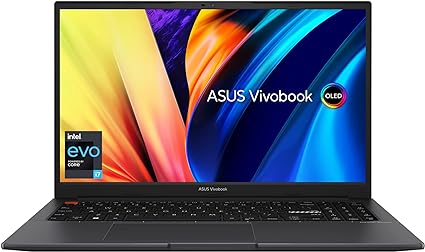
| Model Name | ASUS VivoBook S 15 |
| Screen Size | 15.6 Inches |
| Color | Indie Black |
| Hard Disk Size | 512 GB |
| CPU Model | Intel Core i7 |
| Ram Memory Installed Size | 16 GB |
| Operating System | Windows 11 Home |
| Special Feature | Nanoedge |
| Graphics Card Description | Dedicated |
The ASUS VivoBook S15, with its impressive array of features, makes it a strong contender for mechanical engineering students:
Properties of VivoBook S 15
- Powerful Performance: Equipped with the latest Intel Core i7-12700H processor and Intel Iris Xe graphics, this laptop offers substantial computing power required for running demanding engineering software and simulations.
- Vivid Display: The 15.6” OLED display with 1920 x 1080 resolution, 600 nits peak brightness, and 100% DCI-P3 color gamut ensures accurate color representation and crisp visuals, crucial for tasks like CAD modeling and rendering.
- Fast Storage and Memory: With a combination of 512GB NVMe PCIe 4.0 SSD and 16GB DDR4 RAM, the laptop provides fast data access and multitasking capabilities, enabling smooth operation of multiple engineering applications simultaneously.
- Portability: Weighing only 3.97 lbs and with a thickness of 0.75 inches, the sleek and lightweight aluminum body of the VivoBook S15 ensures easy portability, allowing students to work on their projects from anywhere.
- Ergonomic Design: The chiclet backlit keyboard with a fingerprint sensor offers comfortable typing experience and secure access, while the Windows Hello integration adds convenience and security.
- AI Noise-Canceling Technology: The ASUS AI Noise-Canceling Technology ensures clear communication during online lectures, group discussions, or virtual meetings, which is essential for collaborative work in mechanical engineering projects.
- Intel Evo Platform: The laptop is certified under the Intel Evo platform, ensuring a balance of performance, responsiveness, and battery life. This means students can enjoy extended productivity sessions without worrying about running out of battery.
- Software Subscription: The complimentary 1-month Adobe Creative Cloud subscription adds value, providing access to useful software tools for design, visualization, and creative projects.
Overall, the ASUS VivoBook S15 offers a compelling combination of performance, portability, display quality, and features tailored to meet the demanding requirements of mechanical engineering students, making it a top choice in its category.
6. Lenovo ThinkPad P16s Workstation Business Laptop
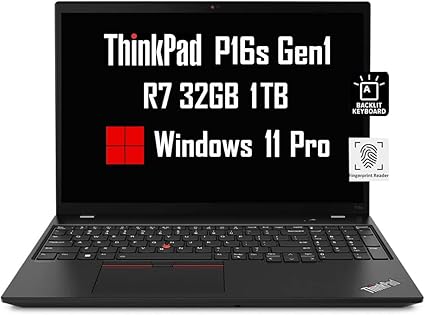
| Model Name | ThinkPad P16s Gen 1 |
| Screen Size | 16 Inches |
| Color | Black |
| Hard Disk Size | 1 TB |
| CPU Model | Ryzen 7 |
| Ram Memory Installed Size | 32 GB |
| Operating System | Windows 11 Pro |
| Special Feature | Fingerprint Reader, NFC, Backlit Keyboard, Anti Glare Coating |
| Graphics Card Description | Integrated |
The Lenovo ThinkPad P16s Workstation Business Laptop is an excellent choice for mechanical engineering students due to several key features that align with their academic and project needs:
Properties of ThinkPad P16s
- Powerful Processor: The AMD Octa-Core Ryzen 7 PRO 6850U with 8 cores and 16 threads ensures smooth multitasking and efficient handling of resource-intensive applications like AutoCAD, MATLAB, and SOLIDWORKS. The base clock speed of 2.7GHz, with the ability to turbo boost to 4.7GHz, provides the necessary computational power for complex simulations and analyses.
- Ample Memory and Storage: With 32GB of LPDDR5 RAM, this laptop can handle large datasets and run multiple applications simultaneously without lag. The 1TB PCIe NVMe M.2 SSD offers fast read and write speeds, ensuring quick boot times and efficient file handling, which is crucial for large project files often used in mechanical engineering.
- High-Quality Display: The 16″ WUXGA (1920×1200) IPS display with a 16:10 aspect ratio provides a larger workspace than the typical 16:9 screens, enhancing productivity. The anti-glare feature and 300 nits brightness ensure comfortable viewing for extended periods, whether in bright classrooms or dimly lit labs.
- Graphics Performance: Integrated AMD Radeon 680M Graphics supports demanding graphical tasks and external digital monitors up to 4K resolution. This is particularly beneficial for detailed design work and simulations in applications like Creo and SOLIDWORKS.
- Connectivity Options: A wide range of ports, including USB 3.2, USB-C, HDMI, and Ethernet, allows for easy connection to peripherals and networks. The ability to connect external monitors and devices is crucial for students who need to present their work or expand their workspace.
- Portability and Durability: The slim design of the P16s makes it more portable than larger 17.3″ models while offering a larger screen than the 15.6″ models with similar weight. This balance of portability and screen size is ideal for students who need to carry their laptops between classes, labs, and study sessions.
- Enhanced Security and Usability: Features like the IR FHD 1080p webcam with a privacy shutter, backlit keyboard, and fingerprint reader provide both security and convenience. These features are valuable for protecting sensitive academic work and providing ease of use in various lighting conditions.
- Advanced Wireless Connectivity: Qualcomm Wi-Fi 6E and Bluetooth 5.1 ensure fast and reliable wireless connectivity, which is essential for online research, collaboration, and accessing cloud-based tools and resources.
- Professional Software Compatibility: The laptop’s certifications from Independent Software Vendors (ISVs) ensure compatibility and reliability with critical applications used in mechanical engineering, such as ArcGIS, AutoCAD, Adobe Photoshop, Creo, MATLAB, and SOLIDWORKS. This guarantees that students can rely on their laptop to run essential software without issues.
- Long Warranty: The 3-year warranty from Lenovo provides peace of mind and ensures support throughout the student’s academic career.
Overall, the Lenovo ThinkPad P16s combines powerful performance, high-quality display, robust connectivity, and portability, making it an ideal choice for mechanical engineering students who require a reliable and efficient laptop for their demanding academic and project needs.
Conclusion
Ultimately, the “best” laptop for a mechanical engineering student comes down to individual needs and budget. By prioritizing key specs like processor, RAM, graphics card, and display quality, along with portability and battery life, students can find a machine that empowers them to excel in their studies and future careers. Regardless of the chosen model, utilizing the resources available and investing in essential accessories will further enhance the learning experience and ensure success in the world of mechanical engineering.
FAQs
Being a mechanical engineering student means juggling complex projects, demanding software, and diverse coursework. The right laptop can be a game-changer, empowering you to learn, design, and innovate. But with endless options, choosing the best one can feel overwhelming. This guide aims to simplify your search by providing clear answers to your frequently asked questions, highlighting key considerations, and showcasing top picks specifically designed for mechanical engineering students. Let’s find the perfect machine to fuel your academic journey!
In this section, we will look for answers to the following frequently asked questions about laptops for mechanical engineers.
- Do you need a powerful laptop for mechanical engineering?
- Should I get a Mac for mechanical engineering?
- How much RAM is needed for mechanical engineering?
- What is the minimum laptop requirements for mechanical engineering?
- What computer do I need for mechanical engineering?
1. Do you need a powerful laptop for mechanical engineering?
Yes, you do need a powerful laptop for mechanical engineering. Mechanical engineering programs typically require the use of resource-intensive software for tasks such as:
- Computer-aided design (CAD): This software is used to create 3D models of parts and assemblies. It requires a powerful processor and graphics card to run smoothly.
- Finite element analysis (FEA): This software is used to analyze the stress and deformation of structures. It also requires a powerful processor and graphics card.
- Computational fluid dynamics (CFD): This software is used to analyze the flow of fluids around objects. It requires a powerful processor and a large amount of RAM
In addition to these specific software programs, mechanical engineering students will also need to use other programs that require a significant amount of processing power, such as:
- Microsoft Office Suite
- Math software programs such as MATLAB
- Programming languages such as Python
Therefore, it is important to choose a laptop that has the following specifications:
- Processor: A powerful processor, such as an Intel Core i7 or AMD Ryzen 7, is essential for running demanding software.
- Graphics card: A dedicated graphics card with at least 4GB of memory is recommended for CAD and other graphics-intensive applications.
- RAM: At least 16GB of RAM is recommended for multitasking and running multiple applications simultaneously.
- Storage: A solid-state drive (SSD) is recommended for fast boot times and application loading. 512GB of storage is a good starting point, but you may need more depending on your needs.
2. Should I get a Mac for mechanical engineering?
Whether or not you should get a Mac for mechanical engineering depends on several factors. Here’s a breakdown of the pros and cons to help you decide:
Pros:
- Build quality and design: Macs are known for their sleek design, durable build quality, and long lifespan. They are also generally lightweight and portable, making them ideal for carrying to and from class or work.
- Operating system: MacOS is known for its user-friendly interface, clean design, and excellent performance. It is also considered more secure than Windows, which can be important for protecting your data.
- Battery life: Macs typically have excellent battery life, allowing you to work or study for hours without needing to recharge.
- Software compatibility: While some engineering software is only available on Windows, many popular programs like SolidWorks, AutoCAD, and MATLAB have Mac versions. Additionally, you can always use virtual machines to run Windows software on your Mac.
- Integration with other Apple devices: If you already own other Apple devices like an iPhone or iPad, a Mac will seamlessly integrate with them, making it easy to share files and work across different platforms.
Cons:
- Price: Macs are generally more expensive than Windows laptops with similar specs.
- Software compatibility: While some engineering software is available on Mac, there are still some programs that are only available on Windows. This can be a problem if you need to use specific software for your courses or projects.
- Limited upgradeability: Macs are not as easy to upgrade as some Windows laptops. This means you may be stuck with the same hardware for several years.
- Gaming: Macs are not the best choice for gaming. If you plan on doing any gaming on your laptop, you may be better off with a Windows machine.
- No touchscreen: While some MacBooks now have touchscreens, the majority do not. If you prefer using a touchscreen, you will need to choose another laptop option.
Here are some additional factors to consider:
- Your budget: If you are on a tight budget, a Windows laptop may be a better option.
- Your existing software: If you already use a lot of Windows software, you may want to stick with a Windows laptop.
- Your personal preference: If you are more comfortable with MacOS, a Mac may be a better choice for you, even if it means sacrificing some software compatibility.
Ultimately, the best way to decide whether or not to get a Mac for mechanical engineering is to weigh the pros and cons carefully and consider your own individual needs and preferences. You may also want to talk to other mechanical engineering students or professionals to get their recommendations.
3. How much RAM is needed for mechanical engineering?
The amount of RAM needed for mechanical engineering depends heavily on several factors:
1. Specific software used: Different software used in mechanical engineering has varying RAM requirements. Here’s a general guide:
- Basic CAD programs: 8GB RAM is usually sufficient for basic CAD programs like Autodesk Inventor or SolidWorks.
- Advanced CAD programs: For complex models and assemblies, 16GB RAM is recommended for programs like ANSYS or CATIA.
- Simulation software: RAM-intensive software like FEA (Finite Element Analysis) or CFD (Computational Fluid Dynamics) can require 32GB or even 64GB RAM for large simulations.
2. Multitasking: If you’ll be running multiple programs simultaneously, such as CAD software, simulation software, and web browsers, more RAM is necessary. Aim for 16GB or 32GB if multitasking is frequent.
3. Futureproofing: If you plan to use more demanding software in the future or keep your computer for several years, consider investing in 32GB RAM for futureproof functionality.
Here’s a breakdown of RAM recommendations for different scenarios:
- Basic mechanical engineering student: 8GB RAM
- General mechanical engineering work: 16GB RAM
- Advanced mechanical engineering work: 32GB RAM
- Futureproofed system: 32GB RAM or 64GB RAM
Additional factors:
- Operating system: Windows generally requires slightly more RAM compared to Linux.
- Background processes: RAM usage increases with more background processes running.
Remember, these are just recommendations. Always check the specific software requirements you plan to use and adjust your RAM accordingly.
4. What is the minimum laptop requirements for mechanical engineering?
- CPU: Intel Core i5 or AMD equivalent
- RAM: 16GB (more is better)
- Storage: 500GB SSD (1TB recommended)
- Graphics card: 2GB dedicated (NVIDIA preferred)
Consider:
- Operating System: Windows 11 preferred
- Portability: Smaller if needed
- Battery life: Longer for longer use
- Ports: Enough for your needs
- Durability: Built to last
5. What computer do I need for mechanical engineering?
The computer requirements for mechanical engineering can vary depending on the specific tasks and software you’ll be using. However, here are some general recommendations:
- Processor (CPU): Look for a modern multicore processor (e.g., Intel Core i5 or i7, AMD Ryzen 5 or 7). A higher number of cores can help with multitasking and running resource-intensive applications.
- Memory (RAM): Aim for at least 8GB of RAM, but 16GB or more is preferable for smoother multitasking and running complex simulations or CAD (Computer-Aided Design) software.
- Graphics Processing Unit (GPU): For CAD and simulation software, a dedicated GPU can significantly improve performance. Look for a mid-range or higher GPU from NVIDIA or AMD. Some software might benefit from workstation-class GPUs like NVIDIA Quadro or AMD Radeon Pro.
- Storage: Opt for solid-state drives (SSDs) for faster boot times and application loading. Consider a larger SSD (256GB or more) for storing software and projects, supplemented by external storage for larger files and backups.
- Display: A high-resolution display (at least 1080p) with good color accuracy is beneficial, especially for CAD work. Some mechanical engineers prefer dual monitors for increased productivity.
- Software: Mechanical engineering software often includes CAD tools (e.g., AutoCAD, SolidWorks), simulation software (e.g., ANSYS, COMSOL), and programming environments (e.g., MATLAB, Python). Ensure your computer meets the software requirements.
- Operating System: Windows is the most commonly used operating system for engineering software compatibility. However, some software also supports macOS or Linux.
- Portability: Consider whether you need a laptop for its portability or if a desktop provides better performance for your needs. Laptops offer flexibility, while desktops often provide better performance for demanding tasks.
- Budget: Your budget will ultimately dictate the specifications you can afford. Balance performance and features based on your budget and specific requirements.
- Future-proofing: Consider investing in slightly higher specifications than your current needs to accommodate future software upgrades and increasing demands of projects.
It’s also a good idea to check with your academic institution or employer for any specific computer requirements or recommendations they may have for mechanical engineering tasks. Additionally, keep in mind that your needs may evolve over time, so flexibility in your computer’s specifications can be beneficial.

